CHICKENS
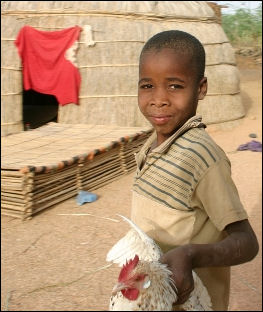
boy with chicken in Niger Chickens have traditionally been valued by villagers because they are an important source of meat and protein and they scavenge for food on their own and cost next to nothing to raise. A male chicken is called a cock or rooster. A female is called a hen. Young are called chicks. A group is called a flock.
Chickens were raised in Egypt and China for meat and eggs by 1400 B.C. Greeks ate them and they were in Britain at the time the Romans arrived. They were brought to New World by explorers and conquistadors.
Poultry are kept for eggs and meat. They require little care and can be sold if necessary for some cash to tide a family over until crops are ready. Egg and chicken meat production has increased over the years. In the 1920 hens laid about 120 eggs a year and it took 16 weeks to raise a two pound meat bird. Today hens lay 300 eggs or more a year a and four pound meat bird can be raised in four weeks.
World’s Top Chicken Exporting and Importing Countries
World’s Top Exporters of Chickens (2020): 1) Germany: 433616 tonnes; 2) Netherlands: 269877,000 Head; 3) Germany: 256019,000 Head; 4) Belgium: 126208,000 Head; 5) Belgium: 125225 tonnes; 6) France: 124864 tonnes; 7) Hungary: 116879,000 Head; 8) Netherlands: 99102 tonnes; 9) France: 97918,000 Head; 10) Czechia: 96529,000 Head; 11) Poland: 69535,000 Head; 12) Denmark: 61051,000 Head; 13) Malaysia: 56491,000 Head; 14) United States: 51896,000 Head; 15) Slovakia: 50004,000 Head; 16) Serbia: 37262,000 Head; 17) Romania: 35512 tonnes; 18) Denmark: 35383 tonnes; 19) Slovakia: 33632 tonnes; 20) Turkey: 32954 tonnes [Source: FAOSTAT, Food and Agriculture Organization (U.N.), fao.org]
World’s Top Exporters (in value terms) of Chickens (2020): 1) Germany: US$504633,000; 2) Netherlands: US$313790,000; 3) United States: US$227513,000; 4) France: US$186102,000; 5) United Kingdom: US$180078,000; 6) Belgium: US$155737,000; 7) Malaysia: US$153489,000; 8) Hungary: US$106232,000; 9) Denmark: US$87570,000; 10) Brazil: US$77891,000; 11) Spain: US$77853,000; 12) Czechia: US$53939,000; 13) Turkey: US$46086,000; 14) Romania: US$33607,000; 15) Slovakia: US$32420,000; 16) New Zealand: US$31927,000; 17) Poland: US$29691,000; 18) Thailand: US$19472,000; 19) Austria: US$16453,000; 20) Sweden: US$14369,000
World’s Top Importers of Chickens (2020): 1) Netherlands: 669455 tonnes; 2) Netherlands: 410911,000 Head; 3) Belgium: 213713 tonnes; 4) Germany: 148774,000 Head; 5) Belgium: 142038,000 Head; 6) Romania:114664,000 Head; 7) Ukraine: 95279,000 Head; 8) Poland: 93128,000 Head; 9) Poland: 89596 tonnes; 10) Germany: 88277 tonnes; 11) Slovakia: 66159,000 Head; 12) Hungary: 47089 tonnes; 13) Singapore: 46109,000 Head; 14) Canada: 36093,000 Head; 15) Austria: 34806 tonnes; 16) Spain: 33532,000 Head; 17) Bosnia and Herzegovina: 33376,000 Head; 18) Afghanistan: 31341,000 Head; 19) Syria: 27575 tonnes; 20) Hungary: 24734,000 Head: [Source: FAOSTAT, Food and Agriculture Organization (U.N.), fao.org]
World’s Top Importers (in value terms) of Chickens (2020): 1) Netherlands: US$685167,000; 2) Belgium: US$200401,000; 3) Germany: US$167632,000; 4) Singapore: US$147930,000; 5) Poland: US$96278,000; 6) Romania: US$60038,000; 7) Hungary: US$60000,000; 8) Canada: US$59643,000; 9) Ukraine: US$56032,000; 10) Austria: US$43446,000; 11) China: US$35721,000; 12) France: US$35067,000; 13) Slovakia: US$35008,000; 14) Spain: US$34991,000; 15) Indonesia: US$31843,000; 16) Syria: US$29703,000; 17) Algeria: US$26988,000; 18) Thailand: US$25096,000; 19) Portugal: US$23600,000; 20) Vietnam: US$22216,000
Domestication of Chickens from Jungle Fowl
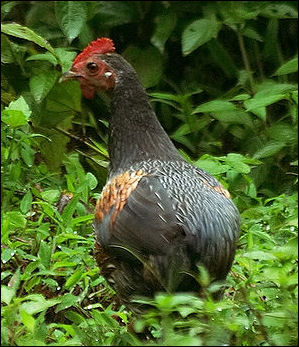
jungle fowl, Gallus sonneratii Chickens were first domesticated from the red jungle cock, a bird native to Thailand, Burma, Laos, eastern India and Sumatra, about 5,000 years ago, apparently as much for the production of fighting cocks as meat and eggs. Male jungle cocks look just like conventional roosters.
Jungle fowl are ground-dwelling birds. They spend most of their time searching for food by kicking their feet backwards and seeing what fruit, seeds and insects turn up. "Jungle fowl roosters cry “cock-a-doodle-doo” to herald the sunrise. Their cock a doodle do is a high pitched, slightly strangulated version of the crow that modern roosters produce. Jungle fowl chicks sometimes have coloring similar to chipmunks, which is ideal camouflage.
Some have speculated that people may have first kept chickens for this symbolic connection with the dawn. In ancient India priests sacrificed chickens to the god of the sun. Other early Asian societies bred the birds for cockfighting.
The jungle fowl adapted easily to domestication. They became a dual-purpose bird. They produced eggs. When the bird grew to old to lay they could be killed for their meat. And of course they also provided cocks for fighting.
See Separate Article BIRDS IN ASIA: JUNGLE FOWL (CHICKENS), KINGFISHERS AND PEACOCKS factsanddetails.com
Chicken Characteristics and Behavior
Chickens belong to the same family of birds as quails, partridges and pheasants. They are the only birds with combs, the fleshy growth on their heads; they generally eat seeds, insects and worms; and can fly several meters to make an escape. An average rooster weighs around 7 pounds, an average hen, 5 pounds.
There are 180 varieties of the 50 standard poultry breeds. White Leghorns are considered the best egg-laying variety. Poultry chickens usually only live for about three weeks before they are slaughtered.
Females usually select males with the largest combs and wattles to mate with. Jungle fowl attacked by round worms usually have smaller combs and wattles that non-infected birds and consequently have a hard time getting a mate. Red combs of roosters contain relatively large amounts of the sugar molecule hylauronan, which some predict will be the next botox-like anti-wrinkle agent.
Females have a defined pecking order, which determines who eats and drinks first. Males control harem-like flocks, which they jealously defend. A rooster show his interests in a hen by spreading his wings and helping her find a nesting site. Chicks break out their shells after 21 days and are up around in a few hours.
When chickens see blood or even red they peck. To keep chickens from pecking each other to death scientists have experimented with outfitting chickens with red contact lenses so they don't see red.
Ancient Avian Bones Found in China: Oldest Example of Chicken Domestication?
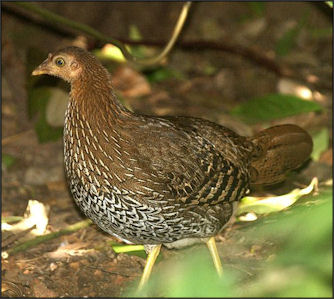
Jungle fowl In November 2014, a team of researchers in China studying ancient avian bones found in the northern part of that country, said there were indication they may be that of the oldest known example of chicken domestication. The scientists described their analysis and findings in a paper published in Proceedings of the National Academy of Sciences, the researchers [Source: Bob Yirka, phys.org, November 25, 2014 ^^^]
Bob Yirka wrote in phys.org: “Identifying the first culture to domesticate chickens has been hotly debated for over a century, without any clear winner, and it may remain that way as evidence is piling up suggesting that chickens were likely domesticated in a variety of places across the globe and have since undergone comingling, creating a mish-mash of genetic evidence. In this new effort, the researchers sought to find out if ancient bone samples found in four different archeological sites in northern China were chicken ancestors and if so, if they were domesticated. The bones were found alongside charcoal and other animal remains, such as dogs and pigs, both of which are believed to have been domesticated by that time in history, suggesting that the bird bones were from a species that had been domesticated as well. The excavation sites have also given up other findings which suggest the people who’d been barbecuing the animals were farmers, not hunters, which also adds credence to the idea that the birds they were eating were domesticated. ^^^
See Separate Article FIRST CROPS AND EARLY AGRICULTURE AND DOMESTICATED ANIMALS IN CHINA factsanddetails.com
First Chickens in the West
Some of the earliest evidence of chickens being consumed as food in the West comes from Maresha, an ancient, abandoned city in Israel that flourished in the Hellenistic period from 400 to 200 B.C.. “The site is located on a trade route between Jerusalem and Egypt,” says Lee Perry-Gal, a doctoral student in the department of archaeology at the University of Haifa. As a result, it was a meeting place of cultures, “like New York City,” she says. [Source: Daniel Charles, NPR, July 20, 2015]
Daniel Charles of NPR wrote: “The surprising thing was not that chickens lived here. There’s evidence that humans have kept chickens around for thousands of years, starting in Southeast Asia and China. But those older sites contained just a few scattered chicken bones. People were raising those chickens for cockfighting, or for special ceremonies. The birds apparently weren’t considered much of a food.
In Maresha, though, something changed. The site contained more than a thousand chicken bones. “They were very, very well-preserved,” says Perry-Gal, whose findings appear in the Proceedings of the National Academy of Sciences. Perry-Gal could see knife marks on them from butchering. There were twice as many bones from female birds as male. These chickens apparently were being raised for their meat, not for cockfighting.
Perry-Gal says there could be a couple of reasons why the people of Maresha decided to eat chickens. Maybe, in the dry Mediterranean climate, people learned better how to raise large numbers of chickens in captivity. Maybe the chickens evolved, physically, and became more attractive as food. But Perry-Gal thinks that part of it must have been a shift in the way people thought about food. “This is a matter of culture,” she says. “You have to decide that you are eating chicken from now on.”
In the history of human cuisine, Maresha may mark a turning point. Barely a century later, the Romans starting spreading the chicken-eating habit across their empire. “From this point on, we see chicken everywhere in Europe,” Perry-Gal says. “We see a bigger and bigger percent of chicken. It’s like a new cellphone. We see it everywhere.”
People in Bulgaria’s Ate Domesticated Chickens 8,000 Years Ago
Ivan Dikov wrote in Archaeologyinbulgaria: “The prehistoric people inhabiting the Early Neolithic settlement near today’s town of Yabalkovo in southern Bulgaria, had domesticated hens some 8,000 years ago, meaning that chickens were raised in Europe much earlier than previously thought, Bulgarian archaeologist Assoc. Prof. Krasimir Leshtakov revealed. Leshtakov, who is a professor of archaeology and prehistory in Sofia University excavated the Neolithic proto-city, which dates back to the 7th millennium B.C., between 2000 and 2012. The settlement near Yabalkovo was first discovered by Bulgarian paleo-ornithologist Prof. Zlatozar Boev from the National Museum of Natural History in Sofia who found bones from domesticated birds there, and was then excavated by archaeologists. [Source: Ivan Dikov, Archaeologyinbulgaria =||=]
“Until recently it had been thought that domesticated chickens became widespread in Europe only after the Arab invasions in the Early Middle Ages (even though there is evidence that domesticated chickens were also known but not widespread in Ancient Greece and Ancient Rome). However, some 8,000 years ago, the prehistoric people at Yabalkovo produced a breed of larger broody hens which could not fly, as indicated by the bones of four broody hens found there Leshtakov has also explained that the Early Neolithic proto-city near Bulgaria’s Yabalkovo is the largest one of its kind in the Balkan Peninsula. Its civilization first came from Anatolia in today’s Turkey, settled the plain around today’s city of Haskovo as well as the Eastern Rhodope Mountains, and probably numbered several tens of thousands which is a fairly large number for that time period. =||=
“Based on his findings, the Bulgarian archaeologist says that in addition to chickens the prehistoric people of Yabalkovo also had domestic pigs, alcohol, white and yellow cheese (called kashkaval in Bulgaria), and raised large herds of goats, sheep, and cattle. These Early Neolithic people also smelted copper which is the earliest case of metallurgy in Europe. Another interesting topic explored in Leshtakov‘s book is connected with the fact that the DNA of the Neolithic inhabitants of the region of Haskovo loosely matches the DNA of today’s residents of the same region, which is taken to mean that the genetic heritage of the prehistoric people who lived there 8,000 years ago is greater than previously imagined. =||=
“The Early Neolithic proto-city near Yabalkovo was first found by Bulgarian paleo-ornithologist Zlatozar Boev after he discovered there bones from 5 domesticated bird species: mute swan (Cygnus olor), two undetermined species resembling geese from the Anser genus, Eurasian coot (Fulica atra), and the bones of four domesticated hens (Gallus gallus f. domestica) which were selected by the prehistoric people to produce a breed of larger broody hens that could not fly. Thus, the Early Neolithic settlement near Bulgaria’s Yabalkovo is the earliest known case of the raising of domestic chickens in Europe. The excavations have also revealed a lot of bones from domesticated livestock such as pigs, goats, sheep, and cattle, and few bones of wild herbivores meaning the Early Neolithic people from Yabalkovo were agriculturalists who did little hunting. Only 3% of their meat is estimated to have come from hunting. They were picky about their rich diet as 75% of the discovered animal bones are from young animals. As indicated by the fish bones and snail shells, they also fished for 10-kilogram carps in the nearby Maritsa River, ate snails (a total of 900 snail shells have been found in a pit on the site). They also grew pistachios, made their bread of spelt (dinkel wheat or hulled wheat, Triticum spelta), and had wine. They also had beer made of sour apples (interestingly, the name of today’s town of Yabalkovo comes from “yabalka”, the Bulgarian word for apple), and probably used formic acid for the beer’s fermentation.” =||=
Chicken Industry
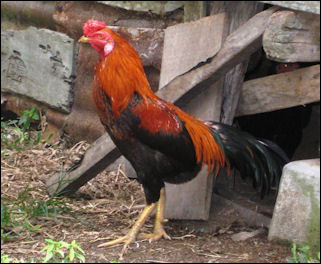
chicken in Malaysia Industrially-raised broiler chickens live for eight weeks and have their beaks cut of with a hot knife so they don’t peck and cannibalize one other. Chicken feed in the United States often contains fish meal from Asia. The use of antibiotics is high in the chicken industry.
Chickens are often slaughtered before their chest muscles are fully developed. The result is less tasty “PSE”—“pale, soft, exudative” — meat. Scientists have developed a breed of featherless chickens, known as naked chicken, that save producers the cost of removing the feathers and have less fat the other chickens.
Industrially-raised egg-laying chickens are packed together indoors with about a half dozen other birds in cages so small the chickens cannot extend their wings and the floor is only large enough for a page of a magazine to cover. Some try to cannibalize one another. Others rub they themselves against their cages until their feathers fall out and their skin bleeds. About 10 percent die. Those that survive are deprived of food and water to get them to lay larger eggs and starved before they die to induce one last bout of stress-induced egg-laying.
In the late 2000s, cage-free chickens and cage-free hens became all the rage in the United States. Sometimes the term “free-range” is used instead of “cage-free.” The term “free range” can be misleading though. Many free range chickens never see the light of day as the sheds they live are often too crowded for them to make their way to opening to get outside.
World’s Top Chicken Meat Producing Countries
World’s Top Producers of Chicken Meat (2020): 1) United States: Chicken Meat: 20490251 tonnes; 2) China: Chicken Meat: 15143887 tonnes; 3) Brazil: 13787480 tonnes; 4) Russia: 4576733 tonnes; 5) Indonesia: 3707876 tonnes; 6) Mexico: 3578694 tonnes; 7) India: 3550636 tonnes; 8) Japan: 2347667 tonnes; 9) Argentina: 2219238 tonnes; 10) Iran: 2219155 tonnes; 11) Poland: 2200280 tonnes; 12) Turkey: 2138451 tonnes; 13) South Africa: 1873238 tonnes; 14) United Kingdom: 1784000 tonnes; 15) Thailand: 1782014 tonnes; 16) Peru: 1723497 tonnes; 17) Pakistan: 1657000 tonnes; 18) Colombia: 1619784 tonnes; 19) Malaysia: 1532028 tonnes; 20) Myanmar: 1500000 tonnes [Source: FAOSTAT, Food and Agriculture Organization (U.N.), fao.org. A tonne (or metric ton) is a metric unit of mass equivalent to 1,000 kilograms (kgs) or 2,204.6 pounds (lbs). A ton is an imperial unit of mass equivalent to 1,016.047 kg or 2,240 lbs.]
World’s Top Exporters of Chicken Meat (2020): 1) Brazil: 3899503 tonnes; 2) United States: 3546799 tonnes; 3) Netherlands: 1169579 tonnes; 4) Poland: 941233 tonnes; 5) Turkey: 522322 tonnes; 6) Belgium: 458749 tonnes; 7) Ukraine: 433117 tonnes; 8) United Kingdom: 377906 tonnes; 9) Thailand: 344044 tonnes; 10) Germany: 254316 tonnes; 11) France: 221228 tonnes; 12) Belarus: 192540 tonnes; 13) Argentina: 179460 tonnes; 14) Russia: 178338 tonnes; 15) China: 161083 tonnes; 16) Spain: 150266 tonnes; 17) Chile: 129299 tonnes; 18) Hungary: 118542 tonnes; 19) Italy: 92131 tonnes; 20) Canada: 91340 tonnes

cockfight cocks Top Chicken-Meat-Producing Countries in 2008 (Production, $1000, Production, metric tons, FAO): 1) United States of America, 18989434 , 16280100; 2) China, 12957495 , 11108773; 3) Brazil, 11948791 , 10243987; 4) Mexico, 3004190 , 2575565; 5) Russian Federation, 2318678 , 1987859; 6) Iran (Islamic Republic of), 1830434 , 1569276; 7) Indonesia, 1775825 , 1522458; 8) Japan, 1592220 , 1365049; 9) United Kingdom, 1508098 , 1292929; 10) Argentina, 1352114 , 1159200; 11) Turkey, 1266757 , 1086683; 12) Spain, 1206571 , 1042777; 13) Colombia, 1191460 , 1021468; 14) Thailand, 1187831 , 1018356; 15) France, 1183916 , 1015000; 16) Canada, 1166420 , 1000000; 17) Malaysia, 1162769 , 996870; 18) South Africa, 1135679 , 973645; 19) Peru, 1025395 , 879096; 20) Australia, 938247 , 804382
World’s Top Chicken Meat Exporting Countries
World’s Top Exporters (in value terms) of Chicken Meat (2020): 1) Brazil: US$5481525,000; 2) United States: US$3411680,000; 3) Netherlands: US$2338837,000; 4) Poland: US$1628003,000; 5) Thailand: US$902505,000; 6) Belgium: US$796166,000; 7) Ukraine: US$557864,000; 8) Turkey: US$530518,000; 9) Germany: US$522534,000; 10) France: US$441213,000; 11) China: US$438498,000; 12) United Kingdom: US$322382,000; 13) Chile: US$307882,000; 14) Belarus: US$290174,000; 15) Spain: US$263025,000; 16) Russia: US$261995,000; 17) Argentina: US$246749,000; 18) Hungary: US$200647,000; 19) Italy: US$194403,000; 20) Austria: US$175863,000
World’s Top Exporters of Canned Chicken Meat (2020): 1) Thailand : 567969 tonnes; 2) China: 256792 tonnes; 3) Germany: 201548 tonnes; 4) Poland: 157652 tonnes; 5) Netherlands: 127979 tonnes; 6) United States: 102722 tonnes; 7) Brazil: 95619 tonnes; 8) Belgium: 68661 tonnes; 9) Denmark: 65739 tonnes; 10) France: 59654 tonnes; 11) Hungary: 48920 tonnes; 12) Canada: 37672 tonnes; 13) United Kingdom: 30306 tonnes; 14) Spain: 29297 tonnes; 15) Turkey: 27590 tonnes; 16) Malaysia: 26132 tonnes; 17) Austria: 23098 tonnes; 18) Ireland: 22696 tonnes; 19) Italy: 21333 tonnes; 20) Chile: 19080 tonnes
World’s Top Exporters (in value terms) of Canned Chicken Meat (2020): 1) Thailand: US$2566746,000; 2) China: US$1049681,000; 3) Germany: US$839916,000; 4) Netherlands: US$556020,000; 5) Poland: US$505596,000; 6) Belgium: US$325793,000; 7) France: US$276172,000; 8) United States: US$270075,000; 9) Brazil: US$264467,000; 10) Denmark: US$247209,000; 11) Canada: US$243552,000; 12) Hungary: US$180509,000; 13) Ireland: US$142646,000; 14) United Kingdom: US$141720,000; 15) Austria: US$105200,000; 16) Spain: US$103676,000; 17) Malaysia: US$102054,000; 18) Italy: US$83755,000; 19) United Arab Emirates: US$75778,000; 20) Romania: US$60540,000
World’s Top Chicken Meat Importing Countries
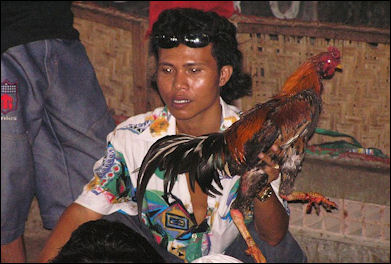
Cock and owner, Bali World’s Top Importers of Chicken Meat (2020): 1) China: 1527148 tonnes; 2) Mexico: 881419 tonnes; 3) Saudi Arabia: 617402 tonnes; 4) Japan: 535031 tonnes; 5) United Arab Emirates: 474939 tonnes; 6) Germany: 470860 tonnes; 7) Hong Kong: 451454 tonnes; 8) Iraq: 428986 tonnes; 9) South Africa: 398923 tonnes; 10) United Kingdom: 368593 tonnes; 11) France: 367112 tonnes; 12) Netherlands: 363525 tonnes; 13) Philippines: 312257 tonnes; 14) Ghana: 283829 tonnes; 15) Taiwan: 251921 tonnes; 16) Cuba: 249546 tonnes; 17) Vietnam: 231848 tonnes; 18) Russia: 217053 tonnes; 19) Angola: 215928 tonnes; 20) Belgium: 204128 tonnes [Source: FAOSTAT, Food and Agriculture Organization (U.N.), fao.org]
World’s Top Importers (in value terms) of Chicken Meat (2020): 1) China: US$3447418,000; 2) United Kingdom: US$1153228,000; 3) Saudi Arabia: US$1114310,000; 4) Germany: US$1105437,000; 5) Japan: US$1098688,000; 6) France: US$963501,000; 7) Hong Kong: US$853446,000; 8) Netherlands: US$761502,000; 9) Mexico: US$731325,000; 10) United Arab Emirates: US$654084,000; 11) Iraq: US$536141,000; 12) Belgium: US$370316,000; 13) Russia: US$304059,000; 14) Ghana: US$284907,000; 15) Kuwait: US$283212,000; 16) Vietnam: US$282975,000; 17) Cuba: US$277055,000; 18) Singapore: US$272035,000; 19) Canada: US$266367,000; 20) South Korea: US$260410,000
Exporters and Importers of Chicken Liver and Chicken Offals
Offals are the intestines and internal organs of an animal consumed as food.
World’s Top Exporters of Chicken Liver and Offals (2020): 1) Poland: 286992 tonnes; 2) Netherlands: 244936 tonnes; 3) Russia: 107673 tonnes; 4) Sweden: 52594 tonnes; 5) United Kingdom: 47255 tonnes; 6) Germany: 44538 tonnes; 7) Belgium: 33139 tonnes; 8) Hungary: 21336 tonnes; 9) Ireland: 15929 tonnes; 10) Denmark: 14567 tonnes; 11) Spain: 11306 tonnes; 12) France: 10157 tonnes; 13) Italy: 8688 tonnes; 14) Austria: 8330 tonnes; 15) South Africa: 6199 tonnes; 16) Greece: 3716 tonnes; 17) Oman: 3514 tonnes; 18) Finland: 2677 tonnes; 19) Latvia: 2174 tonnes; 20) Romania: 2095 tonnes [Source: FAOSTAT, Food and Agriculture Organization (U.N.), fao.org]
World’s Top Exporters (in value terms) of Chicken Liver and Offals (2020): 1) Poland: US$370913,000; 2) Netherlands: US$173088,000; 3) Russia: US$151662,000; 4) Germany: US$18974,000; 5) United Kingdom: US$18716,000; 6) Belgium: US$16162,000; 7) Oman: US$14265,000; 8) Denmark: US$11780,000; 9) Sweden: US$9402,000; 10) Italy: US$9351,000; 11) Spain: US$7582,000; 12) Ireland: US$7457,000; 13) Hungary: US$7290,000; 14) Norway: US$6160,000; 15) South Africa: US$5971,000; 16) France: US$5542,000; 17) Austria: US$4243,000; 18) United Arab Emirates: US$3062,000; 19) Greece: US$1959,000; 20) Czechia: US$1723,000. [Source: FAOSTAT, Food and Agriculture Organization (U.N.), fao.org]
World’s Top Importers of Chicken Liver and Offals (2020): 1) Philippines: 211276 tonnes; 2) Netherlands: 174878 tonnes; 3) Democratic Republic of the Congo: 75274 tonnes; 4) South Africa: 61075 tonnes; 5) Germany: 37429 tonnes; 6) Denmark: 23818 tonnes; 7) Austria: 22041 tonnes; 8) France: 19942 tonnes; 9) Belgium: 18317 tonnes; 10) Honduras: 17391 tonnes; 11) Cuba: 17256 tonnes; 12) Poland: 14852 tonnes; 13) Dominican Republic: 14472 tonnes; 14) Lesotho: 13822 tonnes; 15) Greece: 13364 tonnes; 16) Tajikistan: 10808 tonnes; 17) Hong Kong: 10702 tonnes; 18) Hungary: 10373 tonnes; 19) United Kingdom: 10300 tonnes; 20) Romania: 8500 tonnes [Source: FAOSTAT, Food and Agriculture Organization (U.N.), fao.org]
World’s Top Importers (in value terms) of Chicken Liver and Offals (2020): 1) Philippines: US$212034,000; 2) Netherlands: US$86606,000; 3) United Arab Emirates: US$40716,000; 4) Democratic Republic of the Congo: US$36346,000; 5) South Africa: US$31056,000; 6) Germany: US$24765,000; 7) Dominican Republic: US$24251,000; 8) Tajikistan: US$23459,000; 9) Lesotho: US$22747,000; 10) Denmark: US$20179,000; 11) Honduras: US$19759,000; 12) Cuba: US$18359,000; 13) France: US$14960,000; 14) Belgium: US$14049,000; 15) Hong Kong: US$12336,000; 16) Poland: US$10944,000; 17) Saint Lucia: US$10506,000; 18) Romania: US$8523,000; 19) Hungary: US$7373,000; 20) Russia: US$6251,000
World’s Top Chicken Egg Producing Countries
World’s Top Producers of Chicken Eggs in the Shell (2020): 1) China: 29824800 tonnes; 2) United States: 6607722 tonnes; 3) India: 6292000 tonnes; 4) Indonesia: 5044395 tonnes; 5) Brazil: 3260859 tonnes; 6) Mexico: 3015959 tonnes; 7) Japan: 2632882 tonnes; 8) Russia: 2492190 tonnes; 9) Turkey: 1236754 tonnes; 10) France: 984638 tonnes; 11) Colombia: 982897 tonnes; 12) Pakistan: 946251 tonnes; 13) Ukraine: 924325 tonnes; 14) Spain: 912532 tonnes; 15) Argentina: 873000 tonnes; 16) Germany: 839654 tonnes; 17) Malaysia: 806877 tonnes; 18) United Kingdom: 774000 tonnes; 19) Iran: 755570 tonnes; 20) South Korea: 734528 tonnes
World’s Top Producers (in terms of value) of Chicken Eggs in the Shell (2019): 1) China: Int.$35393317,000 ; 2) United States: Int.$8342444,000 ; 3) India: Int.$7183430,000 ; 4) Indonesia: Int.$5912656,000 ; 5) Brazil: Int.$3928381,000 ; 6) Mexico: Int.$3669187,000 ; 7) Japan: Int.$3283522,000 ; 8) Russia: Int.$3099187,000 ; 9) Turkey: Int.$1546935,000 ; 10) Ukraine: Int.$1186043,000 ; 11) Pakistan: Int.$1113829,000 ; 12) Colombia: Int.$1073427,000 ; 13) Malaysia: Int.$1036228,000 ; 14) Argentina: Int.$1032424,000 ; 15) Spain: Int.$1008714,000 ; 16) United Kingdom: Int.$991376,000 ; 17) France: Int.$977781,000 ; 18) Germany: Int.$949259,000 ; 19) South Korea: Int.$914669,000 ; 20) Iran: Int.$900075,000
Top Hen-Egg Producing Countries in 2008 (Production, $1000; Production, metric tons,FAO): 1) China, 19298017 , 22749200; 2) United States of America, 4012061 , 5338700; 3) India, 2609342 , 3060000; 4) Japan, 2152466 , 2554000; 5) Mexico, 1937843 , 2337215; 6) Russian Federation, 1770081 , 2118500; 7) Brazil, 1302133 , 1844670; 8) Indonesia, 874259, 1122617; 9) France, 766845 , 946800; 10) Ukraine, 700441 , 855200; 11) Turkey, 673454 , 824419; 12) Spain, 651991 , 800000; 13) Germany, 637838 , 789600; 14) Italy, 597202 , 724000; 15) Iran (Islamic Republic of), 557435 , 727000; 16) Netherlands, 500997 , 627000; 17) Poland, 468701 , 581740; 18) Nigeria, 465585 , 552800; 19) United Kingdom, 461318 , 600102; 20) Republic of Korea, 447951 , 566050;
World’s Top Chicken Egg Exporting Countries
World’s Top Exporters of Chicken Eggs in the Shell (2020): 1) Netherlands: 415326 tonnes; 2) Turkey: 217908 tonnes; 3) Poland: 198041 tonnes; 4) United States: 159290 tonnes; 5) Uzbekistan: 125260 tonnes; 6) Spain: 124325 tonnes; 7) Germany: 118438 tonnes; 8) Malaysia: 113755 tonnes; 9) Belgium: 93553 tonnes; 10) China: 72864 tonnes; 11) Belarus: 37239 tonnes; 12) France: 33255 tonnes; 13) Russia: 30046 tonnes; 14) Bulgaria: 22586 tonnes; 15) Latvia: 21527 tonnes; 16) Portugal: 18330 tonnes; 17) Japan: 18120 tonnes; 18) United Kingdom: 17962 tonnes; 19) Czechia: 17803 tonnes; 20) India: 16143 tonnes [Source: FAOSTAT, Food and Agriculture Organization (U.N.), fao.org]
World’s Top Exporters (in value terms) of Chicken Eggs in the Shell (2020): 1) Netherlands: US$738046,000; 2) United States: US$430773,000; 3) Germany: US$264930,000; 4) Poland: US$261863,000; 5) Turkey: US$256130,000; 6) Spain: US$200060,000; 7) Belgium: US$182987,000; 8) United Kingdom: US$124674,000; 9) Malaysia: US$123143,000; 10) China: US$105438,000; 11) France: US$80449,000; 12) Czechia: US$46746,000; 13) Bulgaria: US$43455,000; 14) Japan: US$42941,000; 15) Brazil: US$42195,000; 16) Hungary: US$36768,000; 17) Portugal: US$36239,000; 18) Belarus: US$34117,000; 19) Russia: US$30793,000; 20) Latvia: US$28028,000
Image Sources: Wikimedia Commons
Text Sources: New York Times, Washington Post, Los Angeles Times, Times of London, Yomiuri Shimbun, The Guardian, National Geographic, The New Yorker, Time, Newsweek, Reuters, AP, Lonely Planet Guides, Compton’s Encyclopedia and various books and other publications.
Last updated April 2022
